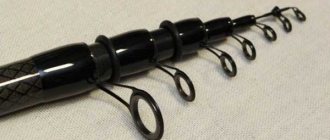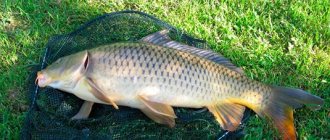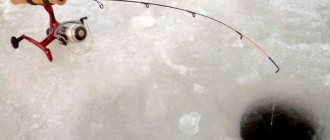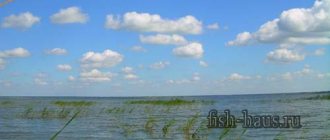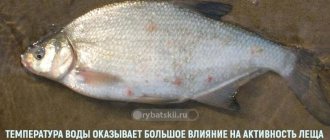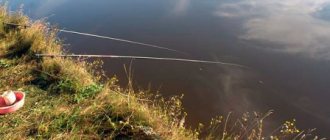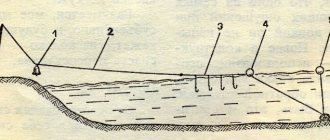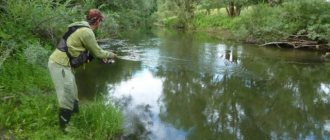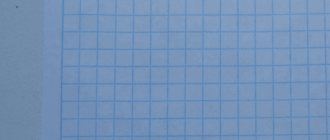For compact places and steep edges
The feeder copes much better than the float with catching complex bottom topography, especially at compact points that the float equipment quickly flies over . On an uneven bottom it is generally impossible to carry out more or less long-term retrieval of the bait near the ground, which is often required in cold water in spring and autumn. And yet the wiring possibilities are wider than they might seem from the outside.
On rivers there are often areas where there is a series of deep holes - the bottom changes are decent, and there are multidirectional jets. There may be a lot of white fish here, but there are even more suitable places to catch them! And where to fish on the river? For feeder fishing, the most obvious option is to feed some edge, the exit from the pit or the entrance to it. But large river squirrels do not like to scatter, but stand in dense schools in compact spots, move little, and if you do not immediately get to such places, then bait will not help. You need to look, and float wiring has more possibilities here. And the fish are found simply by short test swims of the equipment, when the boat is often moved from one place to another. I once discovered a 4.5 m mound running across the river, located next to an 8 m hole, and on this mound the fish were biting just super! Of course, a boat feeder would have fished this place even better if it had been able to find it (previously, how to increase feeder bites). And yet, with a float that is constantly in motion, it is easier to find fish spots.
In general, I think that it is rather reckless to always follow the recommendations of the classics, choosing only “greenhouse” places for long-distance float wiring, ideally a flat, clean bottom with a slight rise towards the end of the wiring, so that the particles of food linger here without being carried too far. But why attract fish to such places with bait? If you can go to it yourself, even if it prefers to stick to the complex bottom topography, where the schools are always denser and bolder, the fish bite right away. You can find the keys to any “crooked” bottom if you set a goal. You can anchor the boat at depth and navigate towards the shallows, setting a small working descent, in accordance with the shallows on which the fish is supposed to be standing. Or vice versa: stand in shallow water and lead with the current towards greater depths, setting up a working descent along them, and it doesn’t matter that at the beginning of the drive the equipment will drag along the bottom for some time.
Now regarding the feeder equipment for the current
The most common and sensitive ones today are loop rigs and Steve Gardner’s rig, also called paternostero.
m. Previously invented and out of fashion sliding equipment, which uses plastic anti-twisters, nevertheless works quite reliably and sensitively in the current.
Leashes for feeder fishing on the river are used quite long - up to 1 meter or more . Their length depends on the strength of river streams and the activity of fish. Of course, shorter leashes get tangled less, and the tackle is generally better controlled, but when the bite is sluggish, long leashes are preferable .
I recommend to read:
Steve Gardner and his paternoster
Spider Feeder Mounting
When the fish bites in the middle layers of water
The usual story is that a white fish hangs in mid-water for some reason, and can remain here in an extremely passive state, or in a fairly active one. Often in the summer this is a mass phenomenon, and how to catch fish in this case? What can a feeder do here? In my opinion, not much. The main option is to actively feed the area where the fish is “hung” in order to still try to lower it to the bottom. Sometimes this works, but more often - no, in any case, I have little idea how you can lower a passive school to the bottom with some kilogram - other bait, especially quickly, and not tomorrow, starting to feed the point today... If the fish is active in half-water, then perhaps it feeds here on some kind of light natural food floating high above the bottom, but it is all the more difficult to lower these individuals to the bottom using feeders, since the fish is already feeding on the food that it is determined to feed on. Experienced bottom fishers also experiment with the length of the leashes, placing especially long ones, trying to lift them above the bottom, planting foam or cork balls. Or they place especially light feeders, which, after casting, slowly lower, floating in the water column. Fishermen hope that the fish will have time to grab the bait during this glide. In my opinion, all of this is the feeder’s attempts to somehow cope with the atypical conditions of fish behavior for which this method is not suitable - it is bottom-based , and these are its advantages and disadvantages.
There are absolutely no problems with the float rod! Simply by moving the float along the vein, you can move the bait at any distance from the bottom with an accuracy of up to a centimeter, presenting the bait ideally in the narrow water horizon where the fish is standing, having the ability to instantly change the working descent if necessary. Moreover, using a bait net, lowered vertically from the side of the boat, it can be fixed at any distance from the bottom, creating a feeding path in the water column.
I won’t say that the river forces me to fish like this often, but it happens. The most illustrative example is catching a large chub on a crust of bread while feeding with the same soaked bread in a feeder. This is very interesting and productive fishing on the river, especially in the hot summer and early autumn. And I figured out long ago that the chub best takes the crust not at the top, not at the very bottom, but high above it. How high? With a total depth of 3-4 m, I set the crust above the bottom at 1-1.5 m, it is in this horizon that the chub takes most often.
Basic principles of fishing techniques
Fishing techniques used in still pond water are different from those effective in rivers. When fishing with a feeder in the current, you can catch different types of fish. The method is suitable for catching ordinary roach or valuable species such as sterlet, sturgeon or trout.
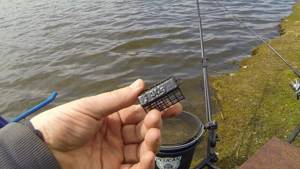
Feeder for feeder fishing
The effectiveness of feeder fishing in the current is high, since a “trail” of bait is formed in the water, attracting prey with its smell. But there are a number of features and tricks, without knowing which it is difficult to count on a rich catch.
- When using a feeder in a current, it is important to cast strictly in one direction. But if the water carries away the gear, then the whole point will be lost. Therefore, the main task of the fisherman is to prevent the feeder from moving. To do this, use heavy weights that anchor the net with complementary foods.
- The shape of the container for bait does not matter much, but it is not recommended to choose round models with an offset center (the so-called bullets). Such feeders roll along the bottom, and it will be difficult to keep them in place.
- To cast the feeder more accurately, select a landmark on the far bank. And to regulate the casting distance, install a clip on the reel.
- Another important point is the thickness of the cord. The larger the diameter, the more difficult it is to prevent the demolition of the food container. Install the rod itself high, building a stand. This reduces the pressure of the water flow on the gear.
- If you plan to fish on a river with a strong current, prepare a viscous feed and pack it tightly into a mesh container so that the feed does not wash out too quickly.
- The addition of molasses temporarily compacts the mass, so that the feed does not immediately crumble. The additive dissolves quite quickly in water, and the complementary food becomes crumbly again.
For the first cast, it is recommended to choose dusty bait - it quickly creates a trail around the feeder that attracts with its smell. Then start adding coarser fractions to keep the fish attracted. Be sure to include the main bait in the mixture.
Fishing in the grass
Continuing the theme of “at mid-water”, there is wire fishing over the bottom grass , which often holds a lot of river fish, primarily large roach and rudd. These grassy areas in many places are not at all obvious even to an experienced fisherman's eye; only from a short distance, if you look closely, you can see small eddies in the flow of water on the surface at depths of about 2-2.5 m. The grass spreads along the bottom in thick strands, rising above the bottom by about half a meter or slightly higher. In the summer heat, these are simply magnificent places where tons of fish hide, and I try to keep an eye on such spots. How to catch them?
Of course, you can look for the edge of these algae, for some gaps among them, in order to fish with a wire along the bottom or throw a feeder with a feeder here from a boat, and this is a good option if you get the hang of catching without snags close to the grass. However, such a study of the bottom will require a lot of time, and I put the bait above the grass, as close to it as possible, as long as the hook does not catch, and the roach bites well. True, the presence of fish in these algae is often uneven, in some places there is more, in others there is less, and in others there is none at all. But it is precisely the wiring over the grass that makes it possible to quickly calculate at random where the fish is standing.
If you fish with a feeder, you can stand upstream from the grass, casting to its edge, luring the fish with bait to the clean bottom. But, in my opinion, this option is not very reliable, since it is not clear in advance how close the roach is. And in the heat, the fish may not reach a clean spot unless they are very hungry.
Still, in such difficult conditions, using a float is easier and more reliable .
Fishing on rocks
There are rivers or separate river sections where there are more stones than grass, and there are enough medium and large boulders that greatly affect the life of fish. Rocks at the bottom of the river concentrate the natural food of many species of fish. They are also a place of shelter for fish, and in general, they largely shape the bottom topography of the river, contributing to the washing out of soft, sandy soil, making small holes of one or another area attractive to fish. Stones also have a strong impact on the formation of the strength and direction of river flow in specific areas.
Based on my practice, the most promising places are along transverse river stone spits, running almost perpendicular to the flow. And the best-biting spits are not made of small stones, but where there are concrete boulders, with a diameter of 1-1.5 m, or even more. Usually I anchor a little upstream from the channel between two boulders, let out a float, and wonderful chubs are taken in the area of these stones. But where large boulders are single, a good bite is very rare.
Fishing in such places is characterized by two features. The first is that hooks quickly become dull, no matter how you fish and what quality you use - the stone dulls the tip of any hook. And the float wiring does not help here, since there are usually more bites at the very bottom, so I set the working descent so that the hook with bait at least periodically strikes along the bottom.
The second point is cliffs. Whatever you use and no matter how you fish, be it with a feeder, or with a spinning rod, or with a fishing rod, breakages are common - whatever catches on the rocks, as a rule, comes off. The spinner loses expensive artificial bait. Feeder - feeders, leashes and hooks. Float - only hooks with a leader line. By the way, the leashes quickly twist in these crazy currents, and no swivels will help, you have to periodically re-tie the leash. The consumption of hooks on cliffs for one fishing trip is about ten. And this is not much compared to shore fishing in such places - there are many times more hooks, and a lot of the same feeder feeders come off.
Equipment of a float rod for bream
The use of float tackle when fishing for chebak is characterized by a high catchability rate, the main thing is to understand that the object of fishing is not suitable for the coastal zone, the tackle must have the appropriate length.
The best option for a float fishing rod is a plug form; with its help you can fish a selected square in a pond and deliver the bait as accurately as possible. It is quite acceptable to use Bolognese and fly rods.
https://www.youtube.com/watch?v=ebTYYji63CM
- Inertia-free reel model with size 1500 – 2500.
- A braided thread with a cross-section of 0.15 - 02 mm or a monofilament with a diameter of 0.17 - 0.25 mm and a length of 100 m is suitable as the main fishing line.
- As a leader material, you can use monofilament fishing line with a cross-section of 0.1 - 0.15 mm and a length of 30 - 50 cm.
- Sliding float type with single point attachment.
- When choosing a load, the strength of the current is taken into account, 6 – 12 g.
- The hook number depends on the weight of the bait, No. 6 - 14.
The type of float depends on the specific fishing conditions (in particular on the fishing speed), namely:
- For fishing in reservoirs with strong currents, it is rational to use products with a thin keel and a flat body shape;
- For reservoirs with standing water, it is effective to use the classic version of a float with a thin cylindrical body.
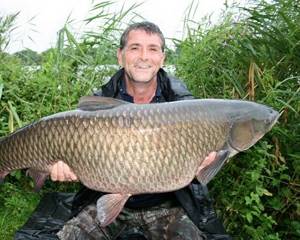
To make it easier to observe the bite, it is recommended to use brightly colored floats.
Another important detail in the equipment of a float tackle is the weight; pellets can also be used, but the sliding version of the weight is considered more effective. So that the bream does not suspect anything when the bait is lifted from the bottom, it is recommended to place all the weights along the main line: the heavy one at the top, and the lighter one closer to the leash.
And here's what you need to know: How to make a homemade feeder for a feeder?
Float tackle works well in small water areas, where its length is enough to fish the selected area.
simple feeder equipment
Feeder tackle depending on the fishing location:
- On wide rivers with currents, rods with a length of 3.9 - 4.2 m are suitable, casting range 70 - 100 m;
- For fishing in small lakes, backwaters and rivers, use a stick with a length of 3 m.
Tackle components:
- A carbon rod with a test load of 80 – 120 g is ideal for catching bream in the current.
- An inertia-free reel model with a size of 2500 - 4000 and a capacity of 150 m3, you can use a carp reel or budget options designed for spinning fishing.
- High-quality monofilament with a cross-section of 0.2 - 0.25 mm, Salmo Feeder Specialist products have proven themselves well. Braid is ineffective here, given the large weight of the feeder, the thread wears out. As a leader material, it is advisable to use fluorocarbon fishing line with a cross-section of 0.2 - 0.25 mm.
- Open weight feeders (cages) with a weight of 80-120 grams work ideally in reservoirs with strong currents, but oval-shaped feeders should be used in standing water near the coastal zone;
- High-quality hooks are also selected taking into account the expected size of the prey: for trophy specimens, 37 - 10 are used, for catching medium and small fish, No. 10 - 14.
Helicopter and two knots
Allows you to hunt bream using light bait (a bunch of maggots). To make a helicopter you will need a rigid fishing thread with a diameter of 0.25 - 0.35 mm; fluorocarbon fishing line works well.
Manufacturing instructions:
- A fishing line with a length of 20 cm is folded in half.
- Tie a small knot, retreating 15 cm along the line folded in a figure eight.
- After 1 cm, twist another figure eight knot.
- Secure the feeder using the “loop-to-loop” method.
- To fix the leash, a throw is made between the first and subsequent knots without twisting the knot.
Symmetrical and asymmetrical loop
There are no significant differences in the installation principle. The differences are visible in the name, where a symmetrical loop has the same lengths of loops, and its antipode is one side shorter than the other, which has a very positive effect on the bite.
The symmetrical loop, despite its ease of assembly, is in no way inferior to the paternoster in terms of efficiency of use. The likelihood of tangling is minimal; it is more suitable for standing water. Equipment elements: main line, feeder, two swivels, leader line and hook.
- The thread folded in half must be twisted with rotational movements (in one direction).
- Tie a knot 6–10 cm from the twist.
- Secure the swivel to one fishing line.
- Make a knot 20 cm from the swivel.
- Twist.
- At the end of the twist, fix the swivel, and attach a leash to it, the length of which should not exceed 70 cm.
- The hook must be mounted on the leash in such a way that a large loop is formed.
- The feeder is mounted on a loop-to-loop swivel.
An asymmetrical loop is used especially effectively in reservoirs with standing water with a consistently calm bite.
- A fishing thread with a length of 50 cm is folded in half.
- Using a knot, the end of such a fishing line is tied to the main thread, the main thing is to get a large circle, it is necessary for attaching the feeder.
- The hook and leash are mounted to the loop.
Paternoster
Fishing in strong winds
The stronger the wind, the less chance the float line has. And it’s not that the bites are hard to see, there are no particular problems with that. You just start catching not from the bait, but somewhere next to it, which is no good. No matter how you anchor, the wind, wave and current do not allow you to clearly anchor the boat, and you end up with a complete bump. And it doesn’t matter how you feed – with a stationary feeder or balls, precise fishing using bait is not possible, and everything gets worse the deeper you go, and when long-distance fishing is required.
In such cases, I try to go to some quiet place, into some channel between the shore and the island, and even though the fish here are small and bite small, you can see a lot of bites.
But for a feeder, fishing in the wind is not so scary if the feeder is on a rig . And although the bite on the tip of the rod in the wind is less visible, this does not negatively affect the fishing - a good river whitefish bites quite sharply.
Feeder feeders for currents
Usually, so-called cage feeders are used for feeder fishing in the current. They are rectangular and triangular. It is clear that various round spirals will simply be carried away by the current. Sometimes, for better installation at the bottom, even rectangular cage feeders are equipped with additional weights or homemade anchors or wire stops. This is better than installing heavier, and therefore voluminous, feeders on the fishing line, which, due to the increase in area, will be subject to even greater water pressure. Additional weights can simply be placed inside the feeder, which will slightly reduce its internal size, but this reduction will be insignificant . When choosing a feeder, do not forget that its weight with complementary foods can double. And this exceeding the test characteristics may cause the gear to break.
Fishing at a great distance from the boat
As a rule, “leading” fish are caught quite close to the boat, including bream. If a feeding trail is formed on the bottom 5-15 m from the boat, a suitable place is chosen, and the feeding is done along the bait, then the fish takes it at the same 5-15 m from the boat. However, in small places this rule may not work. First of all, this applies to catching chub, which on shallow rifts usually takes no closer than 20 m from the boat, no matter how hard you try to lure it closer with the help of bait. This also applies to autumn chub fishing, when large chubs are caught well on the rifts. At the same time, it is clear that they don’t bite all day, they take only short bursts, and guiding from the boat to the bite sites takes a good chunk of time, which is spent ineffectively. Of course, you can cast from a boat the same 20 m as is done from the shore, but then you will actually lose the narrow stern stream coming from the feeder.
But the feeder, when fishing at significant distances, is often more effective than float wiring.
Onboard fishing rod
Another type of tackle for bream is a side fishing rod; it is especially indispensable when catching chebak in places of a reservoir remote from the shore. This is fishing from the side of a watercraft (an inflatable boat or a boat equipped with a motor).
Design features of the onboard fishing rod:
- A fishing tool in the form of a short rod with a length of 40–60 cm, where a nod from a winter fishing rod is used as a signaling device.
- Reliable reel model (inertia-free, inertial) with a size of 1000 – 1500.
- The main fishing line is either a monofilament thread or a braided line with a diameter of 0.15 - 0.25 mm.
- The leader material is made of monofilament with a cross-section of 0.1 – 0.15 mm and a length of 30 – 60 cm.
- Sliding type of load.
- Sharp hook from No. 6 – 14.
A promising place for fishing is determined using an echo sounder, or in the absence of one, you can navigate “by eye.” After which, the watercraft is installed in the right place, the area is fed, and the tackle is immersed in the water. In this case, you can place several rods at the same time, but on different sides.
The bite is indicated by the movement of the nod, and the hooking immediately begins (with a rod or hand on the fishing line).
And here's what you need to know: Review of the Volzhanka Optima feeder. Reviews from fishermen about the Volzhanka Optima feeder
